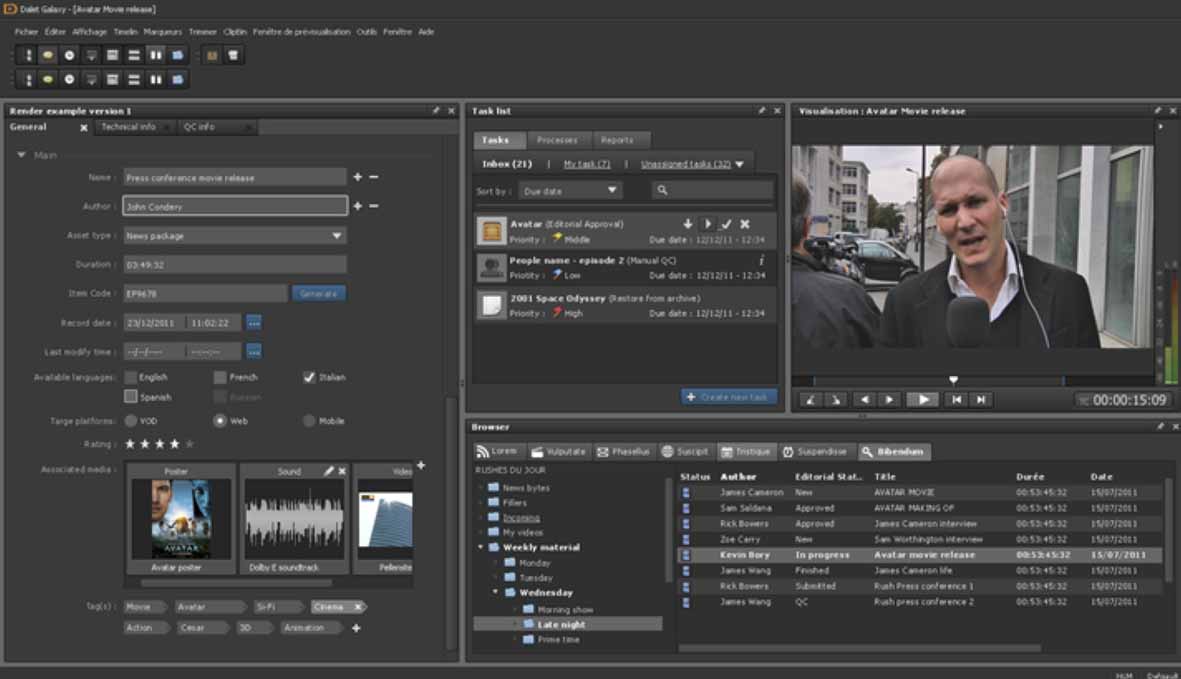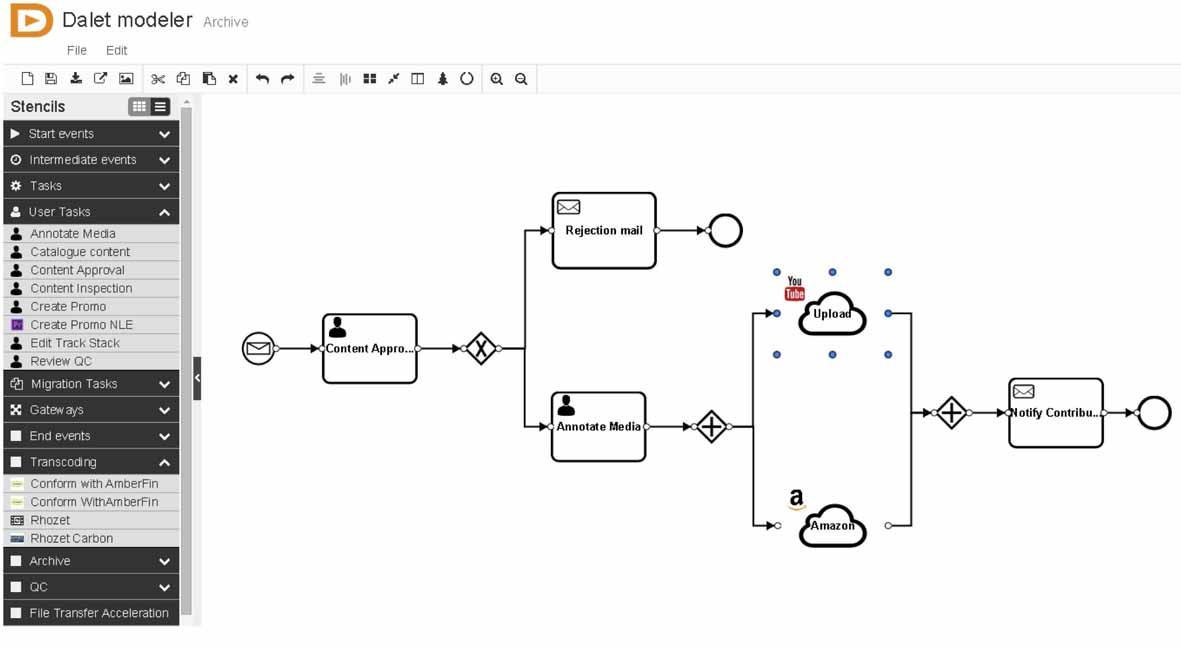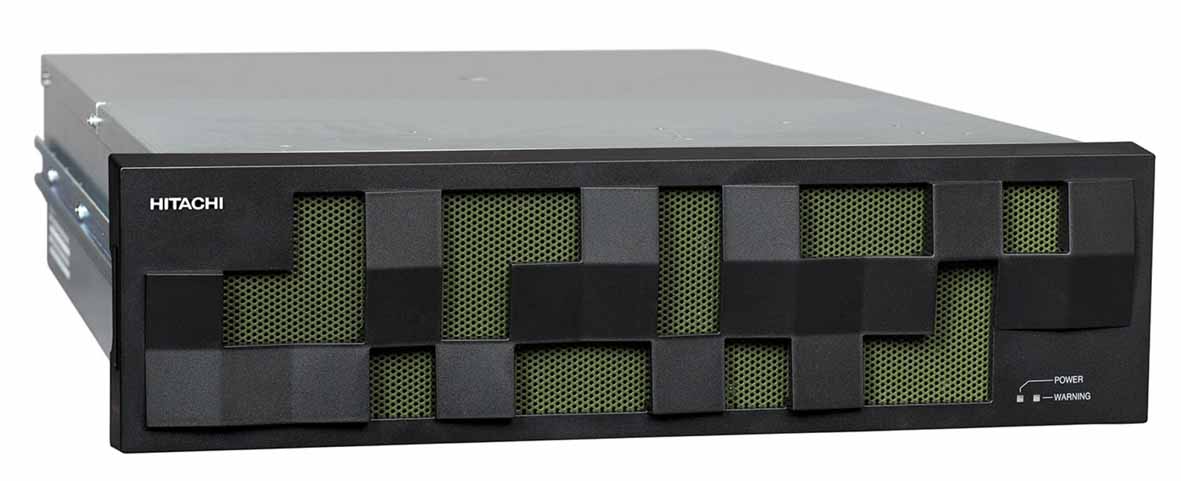Inter BEE 2014 TV: Hitachi unveils French company Dalet's MAM systems in Japan | Working with broadcasters to offer customized solutions | Widely deployed packages offer low-cost file-based workflows
2014.11.28 UP

Hitachi exhibited at Inter BEE 2014 (booth #5404), showing a total of nine products the four areas of production and management, storage and sharing, file receipt and delivery, and archival, all designed as total solutions supporting file-based workflows.
The production and management area was operated jointly with Dalet Digital Media Systems (herein referred to as Dalet), and it presented solutions for workflow automation, content creation and management, and archival.
Dalet is based in France, where it develops and sells Dalet Galaxy, a MAM (media asset management) system. The company has a long track record working with the broadcasting and video industries worldwide. At Inter BEE, Dalet Galaxy was paired with Hitachi hardware to demonstrate how the MAM works.
Dalet Galaxy offers an open format and is flexibly customizable. Paired with Hitachi hardware, which is recognized for its quality and long use for systems integration in the broadcast industry, the system offers a solution that is both reliable and low cost.
■Dalet's strength: intuitive GUI and openness
Dalet Galaxy is a MAM application that consists of two components: a back office engine that handles databases, media processing, and workflow management and a user application with a rich range of features.
Each feature is provided in the form of a module, letting providers select the tools to provide customers. When users need more features or processing power in the future, modules and servers can be added on an ad-hoc basis to easily scale up the service.
For greater user convenience, all of Dalet Galaxy's features are provided in a single client application. The GUI can also be customized to change the layout, including button functions and position.
Dalet Galaxy's workflow engine consists of various tools designed for defining a workflow, automation, and visualization. In addition to allowing the provider to define a workflow that fits users' needs, processes can be automated and data related to the workflow in question can be polled. This data proves to be a valuable reference when redistributing or adding resources.
Dalet Galaxy is also built on principles of open architecture, so it can pair with a range of external applications and hardware to create a comprehensive solution that makes full use of existing systems.
■Why did Hitachi and Dalet choose to collaborate?
Dalet is already partnering with system integrators across the world and has deployed its software at MBC in Korea, MediaCorp in Singapore, and over three hundred broadcasters and media companies around the world. Hitachi has been responsible for bringing Japan's key broadcasting stations into the tapeless age and creating archive systems, so it has deep experience with the media space in Japan. This new collaboration at Inter BEE brings Hitachi's expertise at systems solutions with Dalet's software strengths to create a product calibrated to the needs of Japanese broadcasters.
Katsutoshi Morikoshi, Unit 3 Chief for the Social Solutions Department, Info-Telecoms Systems Network Group, Hitachi, had this to say about what led up to their partnership with Dalet:
"Over the last several years, key stations have pursued tapeless setups for their news systems. Going forward, the same changes will be applied to their programming systems and at local stations. The key will be leaving the workflows each station has created in place and using their existing production capabilities to transition smoothly to a file-based approach. Until now, many of the domestic file-based systems in use were built from scratch, but as more broadcasters seek low-cost implementations, it will be less appropriate to engage in full-scale development from the ground up, which is where these solutions come in."
Directing his comments to those who face the dilemma of leaving their existing workflow in place while still reducing costs, Morikoshi says, "Dalet Galaxy is flexible enough to allow you to build the system around your current workflow. Since it uses various packages, it is more cost-effective than developing a system from the ground up."
Dalet Galaxy offers a flexible way of defining workflows and integrates with a range of products from other makers, letting the user construct a workflow that meets his needs as closely as possible.
Combining this with Hitachi's experience and track record has achieved a solution that is both flexibly customizable and low cost. With this in hand, both sides want to provide a powerful tool to the broadcast and video industries.
■Transitioning smoothly to a file-based system with Hitachi and Dalet
When deploying the system, Hitachi works with the client, using the feature-rich Dalet Galaxy and customizing its GUI and workflow to meet their needs. The idea is that Hitachi is available to support a smooth transition. Where clients need a new application, Hitachi can work with Dalet's R&D team to request that it be built.
For instance, one station was using a custom search GUI with touch panel functionality that resembled the tiled menu seen in Windows 8, and they wanted to continue using that scheme after implementing Dalet Galaxy. Dalet developed a new GUI for this customer. Dalet then went on to incorporate this feature as standard in the Dalet Galaxy product. Feedback from users is readily brought in. This example is typical of the way Dalet shares ideas globally.
Going forward, Hitachi wants to work with Dalet to provide MAM system solutions to not only the broadcast industry, but public organs and municipalities, manufacturers, and other groups to involved in video-based communication and the management of video footage.
■A range of solutions for file-based workflows
The Hitachi NAS Platform (HNAS) was shown as a storage solution for MAM systems. The main feature of HNAS is that a custom FPGA was developed for data access, so it achieves high speeds. This performance is maintained even in implementations that have a mix of sequential and random access. This device has been tested overseas in conjunction with various applications, and it is already being used in the broadcast industry.
Other items on view at Hitachi's booth included StorNext, a SAN file sharing system which allows for high speed access of large data like 4K/8K video content, the Dalet Amberfin, a high-performance transcoder, the JP1/Data Highway, which allows for high-speed transfer of large data over the Internet, and archival schemes using LTO-6 tape libraries and optical disc libraries. These and other solutions for file-based workflows are on view.
Hitachi, Ltd.
Headquarters: 1-6-6 Marunouchi, Chiyoda-ku, Tokyo
URL: http://www.hitachi.co.jp/
Video & broadcasting section/Hall 5/Booth #5404










